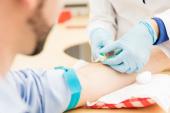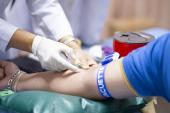US Studies Ease Concerns About Downstream Testing With hs-Troponin
In general, switching to high-sensitivity assays was not associated with major bumps in additional evaluations.

If done with the right preparations, hospital systems can make the switch to high-sensitivity cardiac troponin (hs-cTn) assays for the evaluation of chest pain in the emergency department (ED) without creating a lot of unnecessary downstream testing, the experiences of two US health systems suggest.
When the Mass General Brigham system in Boston, MA, adopted an hs-cTn T assay, there were more troponin tests and ECGs performed, but other evaluations or procedures—like CT scans, stress tests, PCIs, cardiology evaluations, and hospital admissions—declined, researchers led by Ishani Ganguli, MD (Brigham and Women’s Hospital), report.
“We were pleasantly surprised to find that in this case, this new test actually led to fewer high-cost or invasive downstream services,” Ganguli told TCTMD.
Similarly, when two Mayo Clinic Health System hospitals in Wisconsin moved to an hs-cTn T assay, there were big increases in the diagnosis of myocardial injury and MI, but declines in length of stay and use of stress testing. There was a small increase in use of invasive angiography, and no changes in echocardiography or coronary CT angiography, lead author Olatunde Ola, MD (Mayo Clinic Health System, La Crosse, WI), and colleagues report.
The two studies, published in the June 29, 2021, issue of the Journal of the American College of Cardiology, ease concerns that introduction of high-sensitivity troponin testing into the United States, a country that has a reputation for overuse of medical testing and for applying troponin testing to a broader swath of patients than in other parts of the world, would lead to a major increase in additional evaluations with suspect clinical utility.
“The message, I think, is that there is not this huge downstream resource overutilization that many feared,” Yader Sandoval, MD (Mayo Clinic, Rochester, MN), senior author of the Wisconsin-focused study, told TCTMD.
It’s important to note, he added, that these results were achieved only after comprehensive preparation for the switch to an hs-cTn assay, which involved efforts from representatives from several different hospital divisions, meetings, the development of protocols, and extensive education of physicians.
“It’s a huge effort to make sure that everybody is aware of how these tests work, what is the data behind them, how should they be interpreted, and what actions should be taken based on those results,” Sandoval said. “These are not tests that can just be implemented and released into the wild without any education and protocols.”
Ganguli agreed: “The lesson is to not just introduce the test, but be thoughtful about the implementation and introduce protocols and education to make sure that it’s used wisely.”
Mass General Brigham
On April 1, 2018, hospitals across the Mass General Brigham system adopted the fifth-generation hs-cTn T assay from Roche Diagnostics, accompanied by a protocol that recommended additional tests performed 1 or 3 hours after the initial one, with a single test sufficient for select low-risk patients.
Ganguli et al examined the impact of that change on resource use within five EDs using a difference-in-differences analysis that accounted for overall trends in healthcare use and spending at that time. The analysis compared changes from before to after implementation among 7,564 patients with chest pain with what happened during the same time period among 100,415 patients who presented with other symptoms.
The message, I think, is that there is not this huge downstream resource overutilization that many feared. Yader Sandoval
After hs-cTn testing was adopted, patients with chest pain had a 2.8% relative increase in any downstream evaluation compared with the other patients. That was driven by a net 10.5% increase in use of multiple troponin tests and a net increase of 7.1 ECGs per 100 visits.
That increased resource use was counterbalanced by reductions (per 100 visits) in cardiac CT/CT angiography (-1.5), stress testing (-5.9), and PCI (-0.65) in patients with chest pain compared with others. They were also less likely to undergo a cardiology evaluation (-3.5%) or to be hospitalized (-5.8%), and were less likely to receive various cardiac medications.
Overall, patients with chest pain saw a reduction in mean length of stay (-0.24 days) and time spent in the ED (-0.05 days), with no net change in spending on cardiac services.
“On the whole, it seemed like a story where we were seeing fewer cascades or downstream services that may be more invasive or costly,” Ganguli told TCTMD.
Mayo Clinic Health System
Two hospitals within the Mayo Clinic Health System in Wisconsin—located in La Crosse and Sparta— on September 12, 2018, also adopted the fifth-generation hs-cTn T assay from Roche Diagnostics, making the switch from the fourth-generation assay. The new test was deployed using a 0/2-hour protocol. Ola, Sandoval, and colleagues set out to evaluate the impact on both downstream resource use and diagnosis in the ACTION study.
Their analysis included 3,536 unique patients, with 2,069 ED encounters before adoption of hs-cTn testing and 2,491 after; overall, 46% of patients presented with chest discomfort.
Diagnoses were adjudicated according to the Fourth Universal Definition of MI. After hs-cTn T testing was implemented, there was a large increase in the proportion of troponin tests that came in with results above the 99th percentile (15% to 47%), as well as rises in rates of acute MI (3.3% to 8.1%) and myocardial injury (11% to 38%; P < 0.0001 for all). A bigger jump was seen for type 2 MI (1.6% to 5.2%) than for type 1 MI (1.7% to 2.9%).
Using the older assay, women were less likely than men to have any of those diagnoses (except for type 2 MI), but all of those differences were no longer significant in the setting of hs-cTn testing. This is a key finding, Sandoval said, because there’s an ongoing debate about whether sex-specific cutoffs—as were used in both of these studies—are needed. “That’s a critical observation with implementation—that it allows for women to be better diagnosed,” he said.
Regarding resource use in the overall cohort, the length of the ED stay decline slightly from a median of 4.3 to 4.2 hours; P = 0.01), and stress testing became less common (6.5% to 4.9%; P = 0.02). The rate of invasive angiography increased from 2.3% to 3.5% (P < 0.05).
There was no change in the proportion of patients discharged from the ED in the overall cohort, but there was among patients who did not have troponin increases (from 60% to 74%; P < 0.0001). It’s clear that emergency physicians felt more comfortable sending patients home after they started using the high-sensitivity assay, Sandoval said.
Overall, use of the newer tests “will certainly be associated with a lot more diagnosis but that does not appear to be associated with a marked increase in downstream resource utilization, which was the concern that had existed,” he added.
Starting Point Matters
Both studies provide an indication of how hs-cTn testing is going in the United States, which didn’t have access to the newer assays until January 2017, when the US Food and Drug Administration gave 510(k) clearance to the fifth-generation Roche Diagnostics assay.
Sandoval said the findings of the two studies are consistent with much of the experience outside of the US. But it is important to understand, he said, that the impact of the more-sensitive tests’ implementation is heavily influenced by which assay a center was using before the switch. For instance, he said, prior research has shown that the increase in abnormal results that will occur when adopting a high-sensitivity assay is not as great when it comes to the tests that measure troponin I rather than T.
Another key message is that just because these hs-cTn assays can get people out of EDs more quickly and ease overcrowding, that doesn’t mean they won’t need additional medical attention, Sandoval cautioned. “These patients benefit often from having follow-up within primary care or having subsequent evaluations with their cardiologists as clinically indicated,” he said. “So the idea is that these patients will be triaged more efficiently and faster to improve resource utilization, but that doesn’t mean that these patients may not benefit from additional evaluations and follow-up. They often need to be seen again in clinic.”
In an accompanying editorial addressing both studies, Christian Mueller, MD (University Hospital Basel, Switzerland), and colleagues say one of the themes that emerge when placing these findings into a broader context is that “the magnitude of the operational benefits observed with the implementation of hs-cTnT/I is reduced if the full potential of these assays is not used.”
They point to algorithms used extensively in Europe that allow for a decision to be made based on a single, initial troponin result in about one-third of patients, leading to major reductions in the length of time spent in the ED in real-world studies. In the United States, serial testing remains the norm.
Mueller et al also raise questions about use of formal risk scores in US centers and use of sex-specific cutoffs, which “resulted in a disproportional increase in the rule-in of conditions for which currently no evidence-based therapy is available, such as type 2 MI and myocardial injury,” as well as the inclusion of many patients without chest discomfort in the Mayo study.
“Further research as well as continuous interdisciplinary medical education is required to maximize the medical and economic value of hs-cTnT/I testing to patients and institutions,” they write. “This will help reduce overcrowding in the ED, reduce patients’ anxiety and uncertainty, improve patient care, and significantly reduce healthcare costs.”
They estimate that “given the very high number of patients presenting with acute chest discomfort to the ED in North America and Europe, widespread implementation of the [European Society of Cardiology] hs-cTnT/I 0/1-hour algorithm may help save more than 12 billion US dollars in scarce healthcare spending per year.”
Todd Neale is the Associate News Editor for TCTMD and a Senior Medical Journalist. He got his start in journalism at …
Read Full BioSources
Ganguli I, Cui J, Thakore N, Orav EJ, et al. Downstream cascades of care following high-sensitivity troponin test implementation. J Am Coll Cardiol. 2021;77:3171-3179.
Ola O, Akula A, De Michieli L, et al. Clinical impact of high-sensitivity cardiac troponin-T assays in the community. J Am Coll Cardiol. 2021;77:3160-3170.
Mueller C, Boeddinghaus J, Nestelberger T. Downstream consequences of implementing high-sensitivity cardiac troponin: why indication and education matter. J Am Coll Cardiol. 2021;77:3180-3183.
Disclosures
- The work of Ganguli and two co-authors was supported by the Agency for Healthcare Research and Quality. Ganguli reports consulting fees from Blue Cross Blue Shield Massachusetts and grant funding from IBM.
- Publication of the Mayo study was made possible in part by the Mayo Clinic CTSA through a grant from the National Center for Advancing Translational Sciences, part of the National Institutes of Health.
- Sandoval reports having previously served on the advisory boards for Roche Diagnostics and Abbott Diagnostics without personal compensation and having been a speaker without personal financial compensation for Abbott Diagnostics.
- Ola reports no relevant conflicts of interest.
- Mueller reports research support from the University Hospital Basel, the University of Basel, the Swiss National Science Foundation, the Swiss Heart Foundation, the KTI, the Stiftung für kardiovaskuläre Forschung Basel, Abbott, Beckman Coulter, Brahms, Novartis, Ortho Diagnostics, Quidel, Roche, Siemens, Singulex, and Sphingotec; and speaker honoraria/consulting honoraria from Amgen, AstraZeneca, Boehringer Ingelheim, Bristol-Myers Squibb, Daiichi Sankyo, Novartis, Osler, Roche, and Sanofi outside of the submitted work.





Comments